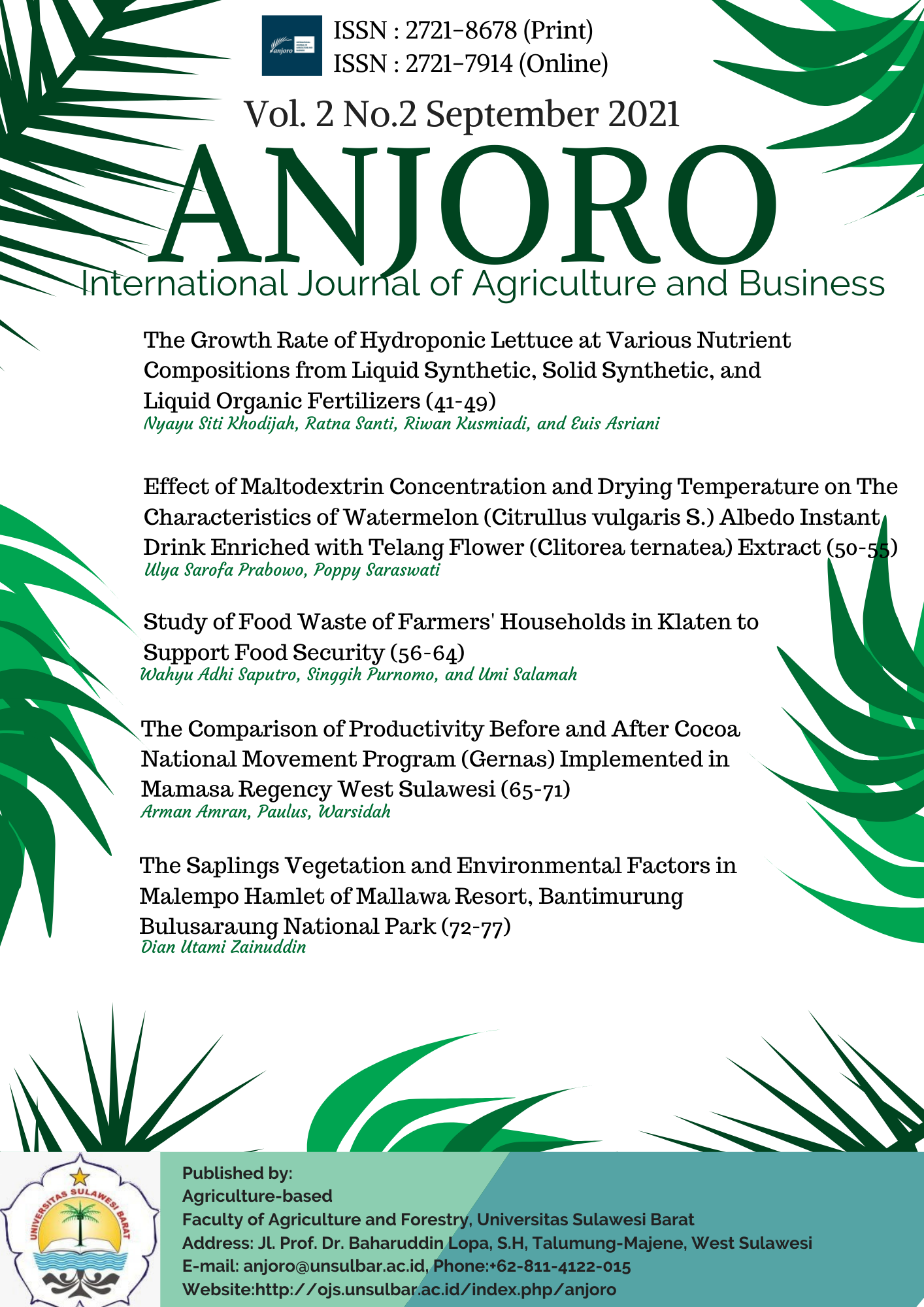Main Article Content
Abstract
The hydroponic system of lettuce cultivation has become popular in the new normal era after the Covid 19 pandemic. So that the efficiency of input and the ease of supplying nutrients in hydroponic farming deserves to be a concern. Hydroponics commonly uses synthetic fertilizers that are completely available and sold commercially. Efforts are needed to make media choices by utilizing easier and cheaper resources, among others by making various alternative nutrient source compositions from widely available, cheap, and commonly used synthetic fertilizers such as NPK and Gandasil. Another option that also needs to be tested for the efficiency of its utilization is the use of liquid organic fertilizers from chicken feather waste. Calculation of the growth rate of lettuce grown on various nutrient compositions of liquid organic and synthetic fertilizers was carried out. The types of fertilizer composition tested were P1= AB-mix (control) 50 ml in 10 liters of water, P2= NPK 10 g + Gandasil 5 g in 10 liters of water, P3= AB-mix 25 ml + 5 g NPK + 2.5 g Gandasil in 10 liters of water, P4= AB-mix 25 ml + 400 ml chicken feather LOF in 10 liters of water, and P5= 5 g NPK + 2.5 g Gandasil + 400 ml chicken feather LOF in 10 liters of water. The results showed that the highest growth rate of lettuce was obtained in the P4 composition, with the best results for Net assimilation rate (NAR), total wet biomass production per plant, ratio of wet weight of shoot: wet weight roots, relative plant height growth rate, relative leaf number growth rate, and relative plant growth rate.
Keywords
Article Details
References
- Barbosa GL, Gadelha FDA, Kublik N, Proctor A, Reichelm L, Weissinger E, et al. Comparison of land, water, and energy requirements of lettuce grown using hydroponic vs. conventional agricultural methods. Int J Environ Res Public Heal. 2015;12:6879–91.
- Kim MJ, Moon Y, Tou JC, Mou B, Waterland NL. Nutritional value, bioactive compounds and health benefits of lettuce (Lactuca sativa L.). J Food Compos Anal. 2016;49:19–34.
- Aini N, Yamika WSD, Ulum B. Effect of nutrient concentration, PGPR and AMF on plant growth, yield and nutrient uptake of hydroponic lettuce. Int J Agric Biol. 2020;21:175–83.
- Sugiyanta DA, Rokhminarsi E, Prakoso B. Growth and yield of shallot (Allium ascalonicum L.) on different types of media and nutrient solution on hydroponic wick system. IOP Conf Ser Earth Environ Sci. IOP Publishing Ltd.; 2021.
- Nguyen VD, Tran DH. Effects of organic foliar nutrient application on lettuce production in Central Vietnam. Res Crop. 2020;21:129–32.
- Maulana MA, Wijaya I, Suroso B. actuca sativa growth response on growth of nutrition and some kinds of growing media on NFT (nutrient film technique) hydroponic system. Agritrop. 2020;18:38–50.
- Zandvakili OR, Barker A V., Hashemi M, Etemadi F, Autio WR. Comparisons of commercial organic and chemical fertilizer solutions on growth and composition of lettuce. J Plant Nutr. 2019;42:990–1000.
- Adiloğlu S, Açıkgöz FE, Solmaz Y, Çaktü E, Adiloğlu A. Effect of vermicompost on the growth and yield of lettuce plant (Lactuca sativa L. var. crispa). Int J Plant Soil Sci. 2018;21:1–5.
- Khan MA, Rehman F ur, Wali H, Mujeeb-ur-rehman, Khan KU, Ayub M, et al. Bioprocessing of agricultural wastes for value added bacterial amylase production. Pak J Agri Sci. 2021;58:261–8.
- Kawamura-Aoyama C, Fujiwara K, Shinohara M, Takano M. Study on the hydroponic culture of lettuce with microbially degraded solid food waste as a nitrate source. JARQ. 2014;48:71–6.
- Sruthi M, Savur B, Kasat D, Mavani U, Singh S, Rane M. Management and utilization of keratin waste-a review. Int J Adv Res Ideas Innov Technol. 2020;6:511–5.
- Ojha S, Gaikwad ST, Suthar T, Gavane A. Microbial bioconversion of poultry waste: value added products. Ind J Pure App Biosci. 2020;8:165–73.
- Zhang X, He D, Niu G, Yan Z, Song J. Effects of environment lighting on the growth, photosynthesis, and quality of hydroponic lettuce in a plant factory. Int J Agric Biol Eng. 2018;11:33–40.
- Sudhakar P, Latha P, Reddy PV. Photosynthetic rates. Phenotyping Crop plants Physiol Biochem Trait. Elsevier Inc.; 2016. p. 33–9.
- Hoffmann WA, Poorter H. Avoiding bias in calculations of relative growth rate. Ann Bot. 2002;80:37–42.
- Setiawan E. Kajian hubungan unsur iklim terhadap produktivitas cabe jamu (Piper retrofractum Vahl) di Kabupaten Sumenep. Agrovigor. 2009;2:1–7.
- Harahap MA, Harahap F, Gultom T. The effect of Ab mix nutrient on growth and yield of pak choi (Brassica chinensis L.) plants under hydroponic wick system condition. J Phys Conf Ser. IOP Publishing Ltd.; 2020.
- Frasetya B, Taofik A, Sholehah M. The evaluation of various nutrient formulation on the growth of lettuce (Lactuca sativa Var. Arista) in hydroponic raft system at tropic region. J Phys Conf Ser. IOP Publishing Ltd.; 2019.
